Search results
83 results found.
83 results found.
Everybody creates their own ranking of what’s important to them, or to their friends, or to the world supply of gum arabic, or to the Ethiopian wolf, and so forth.
Naturally many people would have considered yesterday, the last Sunday of Carnival, to have been a day of supreme importance to Venice. And considering what beautiful, warm, sunny weather was bestowed on the revelers (and, by extension, to the phalanxes of people making money from them), it was indeed a day worth noting.

Lino and I, being somewhat naturally contrary to many kinds of commonly accepted tendencies, did not go to the Piazza San Marco to look at people in costumes. One reason was because we knew we wouldn’t have been able even to get close to the Piazza, and the idea of spending hours standing wedged into a wall of humanity attempting to get there didn’t sound like fun at all. You know the amazing ashlar masonry at Machu Picchu? San Marco would have been like that, with people instead of stones.
So we went to the Palasport, an all-purpose sports facility just around the corner, safely out of the way behind the Naval Museum, to watch a fencing championship.
But this was not just any championship. Our little Venice, which seems to exist only to be looked at, was hosting what happens to be a honking important international sporting event, the 34th Coppa Citta’ di Venezia (City of Venice Cup).
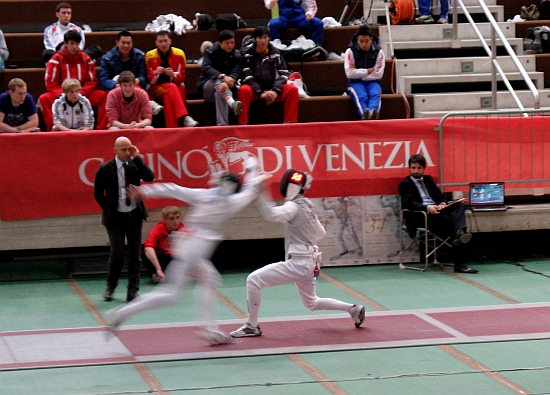
We know nothing about fencing, except that it’s very cool and extremely different from our usual activities. (Years ago I spent a few months at it, trying to get the hang of the basics, but eventually gave up.) So instead of wandering around outside in the sun and fresh air like everybody else, we sat inside for four hours breathing indoor-fluorescent-lights air and watching what amounts to a dramatically physical version of chess.
The City of Venice Cup is one of the most important elements in the Venetian events calendar. Even if you don’t care about sabers, en garde, touche’ or parry and riposte, you might be surprised to learn that this contest is a major component of the World Cup of fencing, Men’s Foil division. Which, I assume, leads eventually to the Olympics.
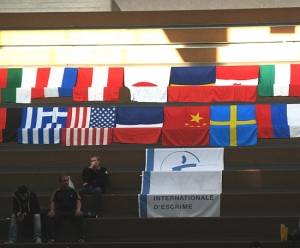
Venice is not merely one of only three cities holding meets composing the world Grand Prix of fencing, the other cities being Tokyo and St. Petersburg. This was the only Men’s Foil competition for the World Cup to be held in Italy. Yes, right here in can-you-bargain-for-a-gondola-ride Venice.
Therefore intense international attention was focused Saturday and Sunday on the athletes, which were among the best in the world. I noticed only a few of the country names on assorted teams: Japan, France, Ukraine, Germany, Korea, Russia, and the increasingly redoubtable China. It was impressive.
We got in (for free, like everybody else) to watch the end of the eliminations, the semi-final, and the final, which was broadcast live on national sports television. From about 3:00 to 7:00 PM, we sat on concrete risers surrounded by families, girlfriends, aficionados, assorted kids, and momentarily unoccupied athletes, most of whom urgently needed to go somewhere and then return by way of the tiny space in front of us. More was going on in the stands than there was on the floor. (I exaggerate, somewhat.) There may not have been thousands of spectators, but we still felt as if we’d parked ourselves on the shoulder of I-95.
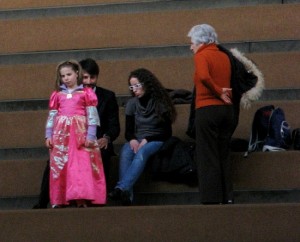
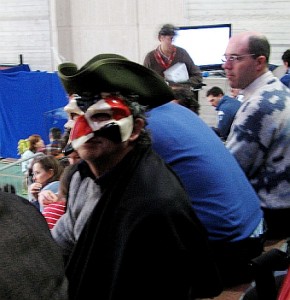
It was gripping to watch. You don’t need to be an expert in the sport, nor to be a fan of any particular competitor, to find yourself involved in what was obviously serious battle at an extremely high level. There were many exotic details — the judges’ gestures were as gnomic as those of a baseball catcher signaling the pitcher, or bidders at an auction — but even in complete ignorance you could appreciate the differing styles of the players and feel the intensity of their confrontation.
The winner by one point was Valerio Aspromonte (for the record), bringing joy to the old Bel Paese. It’s always great to win before a home crowd. Second, by one point, was a certain J.E. Ma, a tall, serene, spectacularly ferocious fencer from China. Third was a tie between Simoncelli and Cheremisinov (Russia). The trophies were large beautiful objects of blown Murano glass.
I was rooting for Ma, but didn’t dare clap or call out his name for fear of being lynched. I loved his concentration, his reflexes, his skill not only in scoring points but avoiding the attacks of his adversary.
Aspromonte’s arsenal of tactics involved a series of highly annoying antics. For example, his primal scream whenever he scored, or whenever his opponent scored. This must be a custom borrowed from soccer, but struck me as ridiculously out of place in a sport (like dressage) which was born of elegance and noblesse.
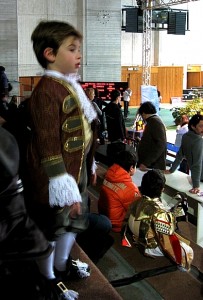
He also frequently stopped, however briefly, to attend to an endless series of temporary, perhaps genuine, injuries (rubbing his ankle — sprained? no, it’s okay — massaging his calf — torn muscle? no, it’s okay — manipulating his shoulder — inflamed rotator cuff? no, it’s okay), and so on. He changed foils three times. He even pulled off his mask after Ma’s foil touched it, rubbing his left temple as if having nearly missed being blinded. I still can’t understand what could have happened behind the wire wall that protects the face, but it was all part of the show. He reminded me of James Brown at the culminating moment of a concert, simulating near-collapse and being helped off the stage, only to suddenly spring to life again.
Outside, there were plenty of kids dressed up as Zorro, or Prince Charming, or a medieval knight, or any other character required to carry some sort of spadroon.
Inside a very ugly cement building there was brilliance and beauty flashing among men who had the real thing, and knew exactly how to use it.
I want to come back next year, but I may bring a big wool sock for Aspromonte. Bless his heart.
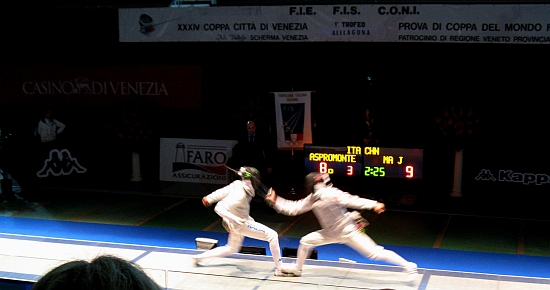
Carnival opened officially last Saturday with the parade of the “Marias.” And it opened in a super-mega-jumbo-cast-of-thousandsly way on Sunday with the “Volo dell’ Angelo,” or flight of the angel, in the Piazza San Marco.
On Saturday we personally got our first taste of Carnival by going — do not ask me why, we must have a death wish — to the Rialto market to shop, as we often do on Saturday morning.
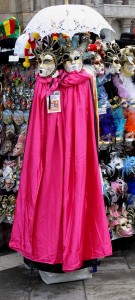
There were so many people in the city at 10:00 AM that they were being left on the vaporetto docks because the vaporettos couldn’t take any more passengers.
Let me pause here, because I don’t want to rant at random. Let me organize the current Carnival scene in as concise a way as I can. And I do this, not because I want to dash glacial water onto anybody’s fantasies of a festival which some widely distributed photographs lead you to believe is made only of dreams and glamor and a batch of feathers. No, I don’t want to do that.
But neither is it Rio or Trinidad or the Fasnacht in Basel or the Carnival in Patras or even, God help us, Mardi Gras in New Orleans. It is a strangely soulless, almost totally manufactured event which every year baffles me more than the year before, the only occurrence here which distresses Venetians more than the cost of living and the lack of affordable housing put together. I’ve lived in other cities which swarm with tourists every day (New York, Washington). The difference is that those are cities. Here, it’s like 70,000 people (official Saturday count) are trying to get into your living room.

So every year I wonder why people come and what they remember when they leave — I mean, apart from the spectacular cost of everything. (A bag of confetti, 2.50 euros, or $3.50, in the Piazza San Marco, is one small example. I ask myself, why acquire pieces of colored paper just to throw them away? You’ll already be doing that with fistfuls of other colored pieces of paper issued by the European Central Bank, beginning the minute you need to pay for anything at all, from a drink to a bathroom, not to mention dinner or a bed.)

Here is what has happened so far:
Parade of the Marias — check. Lovely girls borne aloft on wooden platforms hoisted by gondoliers, and a costumed entourage, wend from San Pietro di Castello to the Piazza San Marco. Great for pictures. So far, so good.
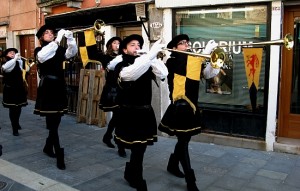
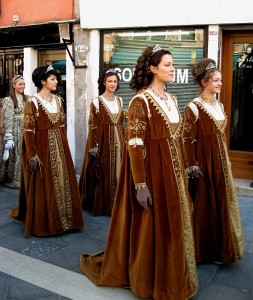
The “Flight of the Angel” — check. Under the Venetian Republic, the intrepid soul who undertook this Flying-Wallendas sort of stunt literally risked (and occasionally lost) his life. This is just a person in a costume sliding down a cable to which she has been cinched at least eight different ways. But there were 80,000 people crammed into the Piazza to watch. Great for pictures.
A “white strike.” I’m not referring to some exotic piece of performance art. It means a major slowdown — not a total strike — by the ACTV, our eccentric public transport company. In its wisdom, the first real weekend of Carnival was clearly the ideal time — two days in which the city’s population doubles — in which to make its labor grievances known, whatever they may be.
On a normal day, the ACTV skips an average of 150 runs anyway. (I’ll wait while that sinks in.) Saturday was worse, because not only did they skip runs at random, thereby creating large accumulations of people at each stop, but the vaporettos went v-e-r-r-r-r-r-y s-l-o-o-o-o-o-o-w-l-y between stops. Seeing as the workers refused to effect extra runs for the entire duration of Carnival, the city was ultimately compelled to hire a private company to provide extra service during peak hours.
Ugo Bergamo, the Assessore (councilor) for Transport, gave a brief interview to explain the situation. To the reporter’s question, “Couldn’t this have been anticipated and prevented?” Mr. Bergamo gave the astonishing reply, “A strike is supposed to create problems, otherwise what kind of a strike is it?” Mr. Bergamo didn’t feel it was appropriate to criticize the ACTV (though plenty of criticism has been made over the past year, not only for erratic service but for ticket sellers stealing money, and the deeply rooted practice of hiring relatives of employees). To him, the ACTV was far more sinned-against than sinning.
He blamed lack of money for problems which were seen as having been imposed on, not created by, the ACTV. (Translation: “Get over it.”) Rather than bring up the strike in the next City Council meeting, he wants us all to take to the barricades to protest the national and regional funding cuts which are flensing the finances of the rogue whale which is the ACTV. Not so great for pictures.
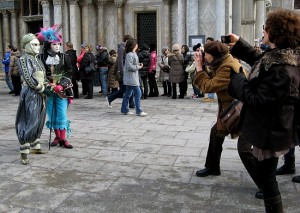
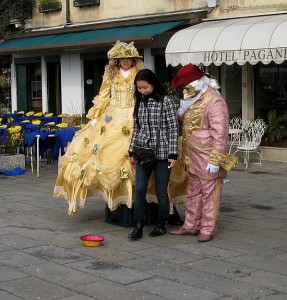
Civil unrest. It was inevitable. In the tiny hours of Sunday night/Monday morning, police and Carabinieri were called to Piazzale Roma to deal with a nascent riot. Hundreds of tired, cold, inebriated revelers had accumulated there expecting to find buses which could take them to the mainland. Well yes, there were a few — so few that the masses essentially assaulted them, while the taxi drivers had to deal with many infuriated people who considered the fares to be a ripoff. (Considering how exorbitant the fares are on a normal day, there’s no telling what the drivers were asking on a Carnival night.) After an hour or two of hard labor, calm was restored, mainly by more buses being brought into service.
“Venice on some occasions demonstrates an alarming lack of direction and coordination,” editor and reporter Davide Scalzotto remarked in an opinion piece the next day. “If this is a city that wants to be considered [as a candidate for] European Capital of Culture, they’d better think it over. That in 2011 one of the world capitals of tourism can’t manage to connect the city on the water with the mainland 24 hours a day is verging on the incredible. First they invite tends of thousands of people to a party and bring lots of money to the ‘touristic categories,’ then they abandon them in the middle of the street to work it out for themselves.”
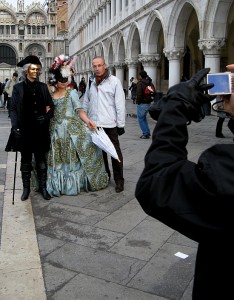
No special trains. This was a departure from past years and obviously creates more logistical misery for the revelers. Negotiations between the city and Trenitalia sputtered and died because nobody could reach an agreement on who would pay the bill for the extra service. Of course we already know that no ghe xe schei. Certainly not here, and evidently not at Trenitalia, either. Perhaps it’s under the potted palm.
The Grand Foyer: Now this was something new. When the partyers finally got to the Piazza San Marco, they discovered that 3/4 of the area had been closed off to form a sort of VIP area called the “Grand Foyer.” Depending on the day, the cost of a ticket to enter this realm ranged from 5 to 100 euros, and was offered as a very special way to enjoy proximity to the stage for the show(s) and some other perks. (Like seats on risers to watch the concert, or bags of confetti for 2.50). The organizers made no secret of their idea that this was intended as another way to make some of that missing schei, but so few people availed themselves of this opportunity– considering that they could see the show just as well from outside the fence — that eventually they let people in for free. (Does this remind you of anything? Peace and love, man.)
It’s true that you could dress up in an expensive rented costume (at least 200 euros) and attend a really glamorous party, like the one given at the Palazzo Pisani-Moretta on the Grand Canal. Tickets to that cost a mere 700 euros.
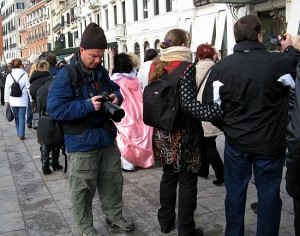
Or you could buy a mask and walk around taking pictures of people in masks and costumes. Or you could skip buying a mask and just walk around taking pictures. This seems to be what most people prefer.
We ran into a friend as we walked home Monday morning, and we indulged in a few choruses of a song which by now one knows all too well, the title of which could be “This isn’t Carnival, this is madness.” “People will do anything just to make money.” “Carnival is dead. Every year they just put more lipstick on the corpse.”
Naturally the city and its various Carnival-not-organizing components have already begun the spin. Speaking of how the Grand Foyer was working out, Piero Rosa Salva, the head of Venezia Eventi e Marketing, tranquilly described it as a sort of creative work-in-progress, an experiment. You can’t call an experiment a mistake, because, well, you’re experimenting. I myself can’t find a way to take seriously a project which could be labeled, “Let’s charge people lots of money for something they can get for free.” (Actually, I haven’t even tried to take it seriously.) But they’re still trying to understand why it didn’t work — so they can make it work better next time. Meanwhile, the private partners (Expo Venice and Attiva), which signed a three-year agreement with the city to share the cost of the stage, among other things, are probably already wondering what they were thinking.
Me, I’m always wondering what they were thinking.
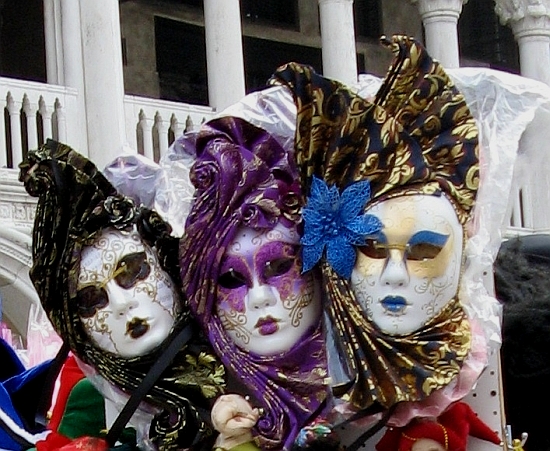
It’s not exactly the swallows returning to Capistrano, but a few mornings ago saw the arrival of a modestly historic moment in the calendar: The amusement park began to set up shop.

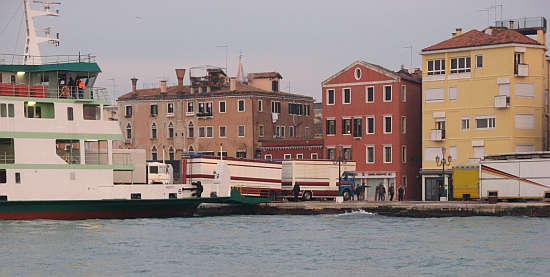
The rides and games, not to mention the stands selling cotton candy, fried dough slathered with nutritional hot-air balloons such as Nutella, caramelized peanuts, and anything else that can emit a powerful odor of imminent obesity, started to disembark, all folded up inside the trucks, on the Riva dei Sette Martiri at the head of via Garibaldi. They will be open for business on Saturday and will remain until the end of Big Famous Bloated Carnival, which this year will be March 8.
Just to avert any possible misunderstanding, BFB Carnival is known here as, well, Carnival, or if you prefer, Carnevale. This little county-fair assortment of playthings is generically called a “Luna Park.” Probably after an Ur-version somewhere bearing that name which I have been unable to identify. It’s no competition for Coney Island or the Prater in Vienna but as everyone knows, available space in Venice is calculated in millimeters.
Till last year, this annual event was set up on the Riva degli Schiavoni between the Arsenal and the next canal on the way to San Marco. But the residents’ complaints about noise, confusion, smells, and garbage finally overrode the carny-people’s desire to be as close to the center of the touristic hurricane as possible.

So last year they were moved just a little bit downstream, to an area beyond the invisible demarcation line separating Tourist Motherlode and Just Somewhere Else in Venice. Hence we now have residents here in this new strip of space that are just as unhappy as their predecessors were over the way, plus unhappy carny-people because they’re missing out, they believe, on loads of business.
They probably have a point (and they ought to know, considering that they’re the ones standing out there in the freezing cold for hours waiting for customers). Whatever their dreams may be of cashing in on the typical tourists, my impression is that this amusement park is frequented almost exclusively by locals.
Which means: Parents and grandparents with small children, and shoals of bored teenagers who will go anywhere in any weather as long as they can hang out with each other and not be home. Of course weekends are the prime moments, but the stands are open every day from mid-afternoon till about 8:00 PM, even though there are few things on earth as unappealing as an amusement park in the middle of a weekday afternoon. The magic of this extraordinary collection of stuff and stimulation, at least for people over ten years old, is that it happens in the dark under glowing, flashing lights. Otherwise this wonderland is just Norma Desmond before her coffee, so to speak, even if it is in the most beautiful city in the world.
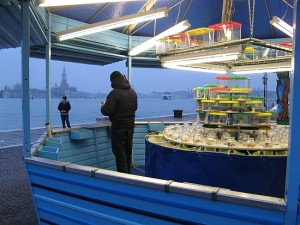
In any case, next year, if the plan is fulfilled, they will move to yet another location, at Tronchetto. This will have the advantage of offering more space, and will solve the problem of irritating the locals with the noise, etc., because there are no locals. I have deep doubts that they will make anything like the money they do here, because Tronchetto is about as convenient to everybody in the city, tourists as well as Venetians, as Whitehorse, Yukon Territory.
I’ll be sorry to see them move away, because no matter how funky it may be, this Luna Park does a lot to sparkle up the winter atmosphere, at least in a neighborhood like ours where the minute you go out the door you run into the same old people doing the same old things making the same old comments. I can tell you that it’s as much fun to watch all the goings-on as it is to participate (I speak as a veteran of the kiddies’ roller-coaster, who last year appalled and offended the two little girls in the car ahead of me not only because I’m an adult but because I screamed on the turns. One of them turned around and asked me scornfully, “Aren’t you a little old to be on this?” This made me laugh, which by the look on her face was not her intention).
Correct answer: Of course I am. So sue me.
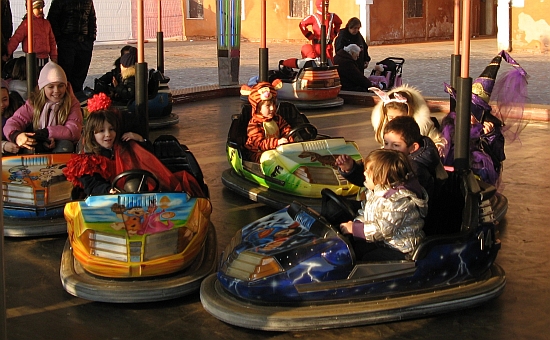
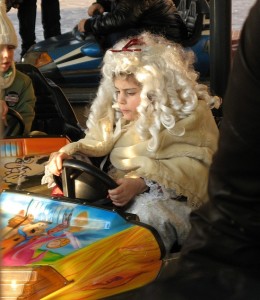
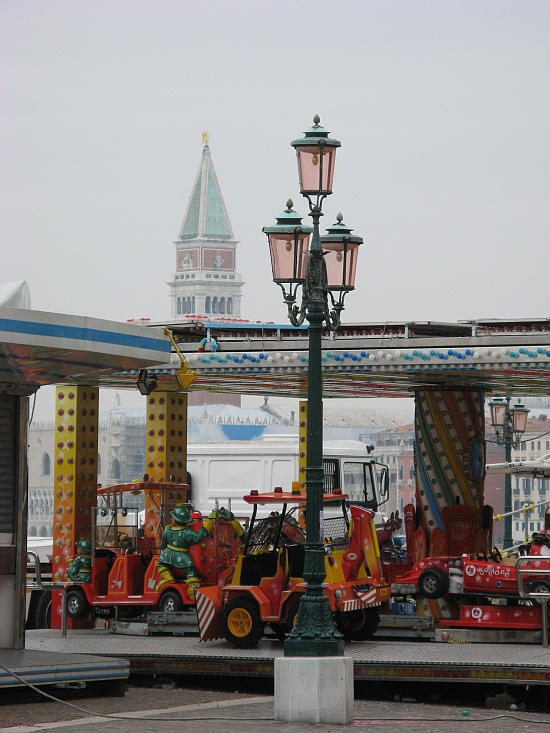
You thought Carnival was over with the sprinkling of the ashes on penitential hairdos? Not quite.
Carnival doesn’t slink away under cover of darkness when the marangon, the basso profundo bell in the campanile of San Marco, tolls midnight on Martedi Grasso. Two things have to happen for it to really be over — in my opinion, that is. Two things which are more predictable than the swallows returning to Capistrano.
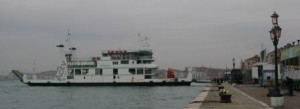
The first is the pulling apart and hauling away of the traveling amusement park (what they generically call a “Luna Park” here) which has been gracing the Riva dei Sette Martiri since — I believe — early December.
These people (as in much of the world) are almost exclusively families which have dedicated many generations to the setting up, operating, pulling down, and rolling on to the next location of their ride or concession stand.
After three months, I’m going to miss the smell of the hot-doughnut-frying-oil and the screeching of the children. It was fun strolling along the waterfront late every afternoon to mingle and kibitz. And I am convinced that as long as there is at least one small child walking home carrying a small plastic bag containing water and a goldfish, the world will not come to an end.
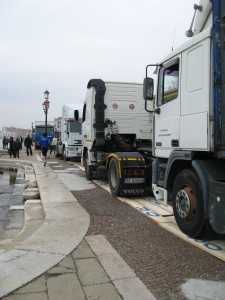
Anyway, the men start work early on Ash Wednesday morning, and by Thursday morning the funfair is gone. The only sign they’ve ever been here are the patches of new cement filling the holes in the pavement where their big rigs (or something) went astray.
Speaking of itinerant carnies, I went to the small town of Bergantino a few years ago when I was working on a story about the Po River (National Geographic, May, 2002). This former farming town has, since the Twenties and much more since the Sixties, become dedicated to the design, construction, and (eventually) operation of carnival rides — merry-go-rounds, bumper cars, etc. Despite the town’s modest size — it’s really just a village of some 2,000 people, when they’re all there, I mean, and not out on the road — they’ve carved away a heavy slice of this international industry for Italy. One of the major markets for their inventions is the USA.
Well, wherever they’ve gone, I’m already missing them.
The second element of the end of Carnival is the orgy of articles, editorials, and letters in the Gazzettino reviewing, celebrating, and vilifying the festivities just concluded. I can tell you without even having opened the paper that there will have been too many people for this fragile city to support; that the managing of this predictable overload will have shown inexcusable organizational flaws and failures to resolve the most elementary large-event necessities (toilets, in a word); that the money taken in doesn’t justify the stress and expense to the city; that it will have lacked originality and creative genius, and that for the residents and shopkeepers of Campo Santa Margherita, the ten days just concluded have been nothing less than at least six of the nine rings of hell.
And every year, the apex of all the claims and counter-claims: That this event would be (or ought to have been, or next year definitely will be) the “Carnival of the Venetians.” I saw Venetians having a fine time carnivalizing in their own modest way in various neighborhoods of the city, but not in the Piazza San Marco. I’d have given you a cash prize if you’d found any Venetians besides Lino in the Piazza San Marco.
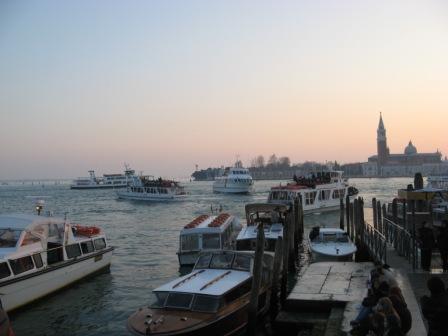
So when this wish to involve Venetians is mentioned, as if it were obviously a good thing, I ask myself if the speaker believes that a “Carnival of the Venetians” would have the slightest probability of pouring the millions of euros into the municipal strongboxes that all those tourists do. After all, Venetians don’t spend money on hotel rooms, restaurant meals, fancy masks, or whatever else makes Carnival matter. So frankly, what would be the point of spending money to organize a ten-day carnival for the few remaining locals? Just wondering.
Let’s go to the videotape (so to speak). Here is a smattering of the Gazzettino’s overview of Carnival 2010, as published yesterday:
The organizers claim that 150,000 people came the first Sunday; 250,000 the second Sunday (let that sink in…) and 40,000 on Martedi Grasso. Altogether, they say a total of 800,000 people came to Venice during Carnival. Perhaps not much compared to Rio, but for a city that covers a mere three square miles, not bad.
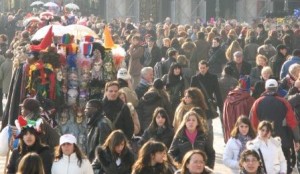 They estimate that each visitor spent 50 euros, for an exciting total income of 40 million euros. Not sure where this number came from; a professor of the Economics of Tourism at the University of Venice says that the “bite and run” day-trippers spend an average of 30 euros each day, while the more solid tourist spends 150. In any case, let’s not quibble over a million more or a million less. Restaurants and hotels certainly made money, not to mention the ACTV and their spectacularly expensive vaporetto tickets.
They estimate that each visitor spent 50 euros, for an exciting total income of 40 million euros. Not sure where this number came from; a professor of the Economics of Tourism at the University of Venice says that the “bite and run” day-trippers spend an average of 30 euros each day, while the more solid tourist spends 150. In any case, let’s not quibble over a million more or a million less. Restaurants and hotels certainly made money, not to mention the ACTV and their spectacularly expensive vaporetto tickets.
One new comment is by the businesspeople (especiallythose of restaurants and cafes) in the Piazza San Marco — they don’t want a maxi-stage there anymore. I’m not sure why, but I imagine it’s because it takes up too much space which needs to be available for them to put out their tables and chairs.
I could go on, but it’s probably not that interesting. These few days following Carnival are mainly spent in a sort of emotional and mental scrubbing and disinfecting.
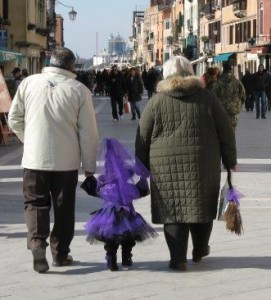
The summary is fairly concise. Apart from numbers, claims, and counter-claims as to success or failure, as one reporter wrote, “Now the Venetians can give a deep sigh of relief and put their hands on their foreheads and say, “‘Once again we’ve lived through it.'”